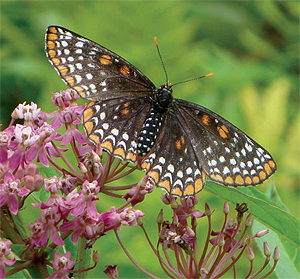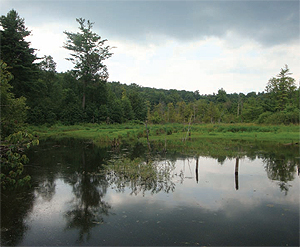Working Forest in French Creek Protected
When Troy Firth and his wife Lynn purchased 400 acres of pristine woodlands in French Creek Township, they envisioned a working forest managed to the highest ecological standards that also supported the local economy.

The Baltimore checkerspot butterfly is commonly found in wetlands near the French Creek watershed.
The Firths reached out to WPC to explore partnership opportunities that would allow them to continue to manage the property with their nonprofit organization, the Foundation for Sustainable Forests. A conservation easement agreement, finalized in September, has proven to be a “win-win” for everyone involved.
“We’re incredibly grateful to partner with the Conservancy, because it enables us to further our work,” said John Bartlett, development director of the nonprofit foundation. “The support the Conservancy has given us has been phenomenal.”
The forest will continue to be sustainably harvested and provide economic benefits to the community. A conservation easement is a voluntary legal agreement between a private landowner and a nonprofit organization that limits future uses of the land in order to protect its conservation values.
WPC has welcomed the alliance, too. “Retaining this land as forest is important, especially because it is sloped,” said Charles Bier, WPC’s senior director of conservation science. “Keeping it forested will help mitigate the impacts of storm events and keep the water from heating up as much.”

French Creek floodplain.
That, in turn, protects species that live in the creek, including the eastern hellbender, a rare salamander that is sensitive to changes in water quality. “There are also darters in that stretch of the creek, and a number of mussel species, including the endangered northern riffleshell.”
“Although it remains in private ownership, the property will be open to the public for outdoor recreation, which will give people the opportunity to experience, enjoy and learn more about this exceptional quality watershed,” said Ann Sand, WPC land protection specialist.
